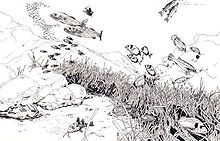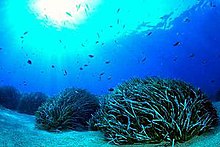Deniz eriştesi: Revizyonlar arasındaki fark
Yeni sayfa: {{taxobox |image = Posidonia 2 Alberto Romeo.jpg |regnum = Plantae |unranked_divisio = Angiosperms |unranked_classis = Monocots |ordo = Alismatales |familia = Posido... |
(Fark yok)
|
Sayfanın 17.14, 26 Ekim 2012 tarihindeki hâli
| Deniz eriştesi | ||
|---|---|---|
| Biyolojik sınıflandırma | ||
|
Posidonia oceanica (Neptün Otu olarak da bilinir) karadan denize dönüş yapmış olan Akdenize endemik çiçekli bir bitkidir deniz otudur. Deniz tabanında 30 metre derinliğe kadar inen ve kıyı ekosisteminde çok önemli yer tutan çayırlar oluşturur. Su altında çiçek açtığı belgelenmiştir. Lifli yapıdaki egagropili adı verilen meyveleri sahile vurur.
Tanım

P. oceanica is a flowering plant Akdenizin kumluk kıyı bölgelerinde 30 metre derinliğe toprak altı gövdesi (rizom) yardımıyla yayılan ve kıyı erozyonunu büyük ölçekte önleyen tek çenekliler grubundan çiçekli bir bitkidir.
Yaprakları 6 veya 7li tutamsı şeritler halinde 1,5 metre uzunluğa kadar erişir. Yaprakların ortalama genişliği 10 mmdir ve üzerinde 13 ila 17 arasında değişen paralel uzanan damarlar bulunur.
The rhizome type stems are found in two forms: one growing up to 150 santimetre (59 in) beneath the sand and the other rising above the sand. All stems are approximately 10 milimetre (0,39 in) thick and upright in habit. This arrangement of the rhizomes eventually forms a mat; the surface contains the active parts of the plant, whereas the center is a dense network of roots and decomposing stems.
The flowering plant's common name is Neptune grass.[1] In 2006 a huge clonal colony of P. oceanica was discovered south of the island of Ibiza. At 8 kilometre (5,0 mi) across, and estimated at around 100,000 years old [2], it may be one of the largest and oldest clonal colonies on Earth.[3][4][5]

Yayılışı ve yaşama ortamı

This species is found only in the Mediterranean Sea where it is in decline, occupying an area of only about 3% of the basin. This corresponds to a surface area of about 38.000 kilometrekare (15.000 sq mi). Posidonia grows best in clean waters, and its presence is a marker for lack of pollution.[kaynak belirtilmeli] The presence of Posidonia can be detected by the masses of decomposing leaves on beaches. Such plant material has been used for composting, but Italian laws prohibit the use of marine algae and plants for this purpose.[kaynak belirtilmeli]
Sınıflandırma
The genus Posidonia is named after Poseidon, the Greek god of the seas, while oceanica refers to its former wide distribution. Carl Linnaeus gave the first botanical description of this species in Systema Naturae, although the genus was then named Zostera. The APG system (1998) and APG II system (2003) accept the genus as constituting the sole genus in the family Posidoniaceae, which it places in the order Alismatales, in the clade monocots. The Angiosperm Phylogeny Website concludes that the three families Cymodoceaceae, Posidoniaceae and Ruppiaceae form a monophyletic group.[6] Earlier systems classified this genus in the family Potamogetonaceae or in the family Posidoniaceae but belonging to order Zosterales.
İkincil metabolitler
To date 51 natural products have been reported from P. oceanica, including natural phenols, phenylmethane derivatives, phenylethane derivatives, phenylpropane derivatives and their esters, chalkones, flavonols, 5-alpha-cholestanes, and cholest-5-enes. Many of the compounds reported for P. oceanica were, however, not detected by appropriate phytochemical methods and some most probably represent artifacts and are not genuine natural products.[7]
See also
Kaynakça

- ^ "Posidonia oceanis".
- ^ "Portuguese scientists discover world's oldest living organism".
- ^ Ibiza Spotlight (28 May 2006). "Ibiza's Monster Marine Plant". Erişim tarihi: 2007-05-09.
- ^ Pearlman, Jonathan (7 February 2012). "'Oldest living thing on earth' discovered". The Telegraph. Erişim tarihi: 11 February 2012.
- ^ Arnaud-Haond, Sophie. "Implications of Extreme Life Span in Clonal Organisms: Millenary Clones in Meadows of the Threatened Seagrass Posidonia oceanica". PLoS ONE. 7 (2): e30454. doi:10.1371/journal.pone.0030454. Bilinmeyen parametre
|coauthors=görmezden gelindi (yardım) - ^ "Alismatales". Mobot.org. Erişim tarihi: 11 February 2012.
- ^ Heglmeier, A; Zidorn, C (October 2010). "Secondary metabolites of Posidonia oceanica". Biochemical Systematics and Ecology (Amsterdam, The Netherlands). 38 (5): 964–70. doi:10.1016/j.bse.2010.07.001. ISSN 0305-1978.
Dış bağlantılar
![]() Wikimedia Commons'ta Deniz eriştesi ile ilgili çoklu ortam belgeleri bulunur.
Wikimedia Commons'ta Deniz eriştesi ile ilgili çoklu ortam belgeleri bulunur.
- Posidoniaceae in L. Watson and M. J. Dallwitz (1992 onwards) The families of flowering plants
- National Center for Biotechnology Information
- Germplasm Resources Information Network: Posidonia
- Flora Europaea: Posidonia
- Ibiza's Monster Marine Plant. Ibiza Spotlight, 28 May 2006.

